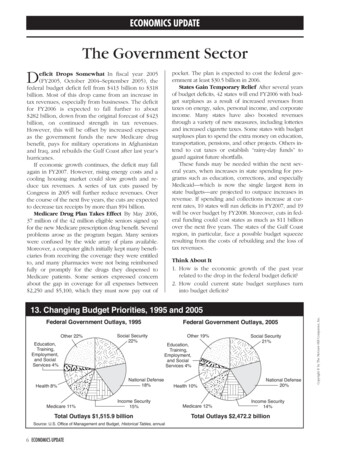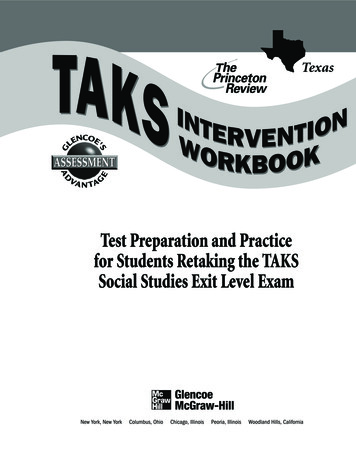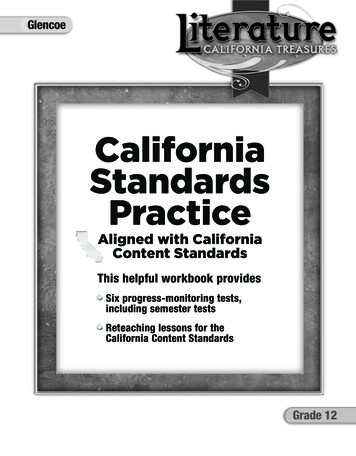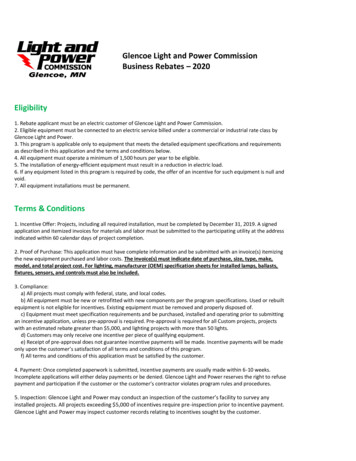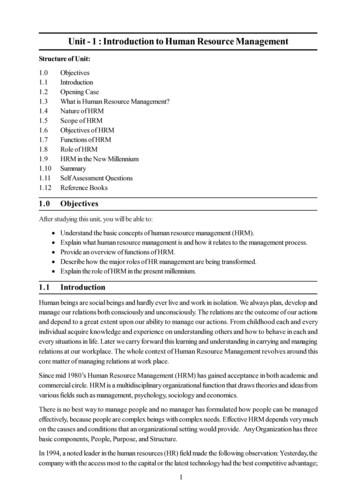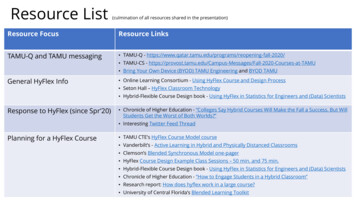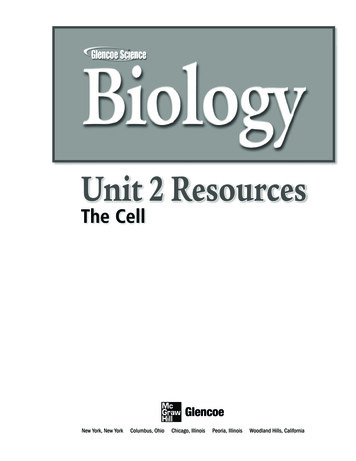
Transcription
Unit 2 ResourcesThe Cell
A GLENCOE PROGRAMBIOLOGYbiologygmh.comCheck out the following features on your Online Learning Center:Study Tools Interactive Tables Interactive Time Line Animated illustrations National Geographic Visualizing animationsSelf-Check QuizzesChapter TestsStandardized Test PracticeVocabulary PuzzleMakerInteractive TutorMultilingual Science GlossaryStudy to GoOnline Student EditionExtensionsVirtual LabsMicroscopy LinksPeriodic Table LinksCareer LinksWeb LinksWebQuest ProjectsScience Fair IdeasInternet BioLabsFor TeachersTeacher ForumTeaching Today, and much more!Send all inquiries to:Glencoe/McGraw-Hill8787 Orion PlaceColumbus, OH 43240-4027ISBN 13: 978-0-07-874606-2ISBN 10: 0-07-874606-XPrinted in the United States of America1 2 3 4 5 6 7 8 9 10 045 11 10 09 08 07 06Copyright Glencoe/McGraw-Hill, a division of The McGraw-Hill Companies, Inc.Copyright by The McGraw-Hill Companies, Inc. All rights reserved.Permission is granted to reproduce the material contained herein on the conditionthat such material be reproduced only for classroom use; be provided to students,teachers, and families without charge; and be used solely in conjunction with theGlencoe Biology program. Any other reproduction, for use or sale, is prohibitedwithout prior written permission of the publisher.
Teacher Approval InitialsDate of ApprovalStudent Lab Safety FormStudent Name:Date:Lab Title:In order to show your teacher that you understand the safety concerns of this lab, thefollowing questions must be answered after the teacher explains the information to you.You must have your teacher initial this form before you can proceed with the lab.Copyright Glencoe/McGraw-Hill, a division of The McGraw-Hill Companies, Inc.1. How would you describe what you will be doing during this lab?2. What are the safety concerns associated with this lab (as explained by your teacher)? 3. What additional safety concerns or questions do you have?Adapted from Gerlovich, et al. (2004). The Total Science Safety System CD, JaKel, Inc.Used with Permission.1
Table ofContentsReproducible PagesChapter 6 Chemistry in BiologyDiagnostic Test . . . . . . . . . . . . . . . . . . . . . . . . . . . . . . . 3Launch Lab . . . . . . . . . . . . . . . . . . . . . . . . . . . . . . . . . 4MiniLab (1) . . . . . . . . . . . . . . . . . . . . . . . . . . . . . . . . . 5MiniLab (2) . . . . . . . . . . . . . . . . . . . . . . . . . . . . . . . . . 6BioLab . . . . . . . . . . . . . . . . . . . . . . . . . . . . . . . . . . . 7Real-World Biology . . . . . . . . . . . . . . . . . . . . . . . . . . . . . 9Enrichment . . . . . . . . . . . . . . . . . . . . . . . . . . . . . . . . . 11Concept Mapping . . . . . . . . . . . . . . . . . . . . . . . . . . . . . . 12Study Guide (English) . . . . . . . . . . . . . . . . . . . . . . . . . . . . 13Study Guide (Spanish) . . . . . . . . . . . . . . . . . . . . . . . . . . . 17Section Quick Check 1 . . . . . . . . . . . . . . . . . . . . . . . . . . . 21Section Quick Check 3 . . . . . . . . . . . . . . . . . . . . . . . . . . . 23Section Quick Check 4 . . . . . . . . . . . . . . . . . . . . . . . . . . . 24Chapter Test A . . . . . . . . . . . . . . . . . . . . . . . . . . . . . . . 25Chapter Test B . . . . . . . . . . . . . . . . . . . . . . . . . . . . . . . 28Chapter Test C . . . . . . . . . . . . . . . . . . . . . . . . . . . . . . . 31Student Recording Sheet . . . . . . . . . . . . . . . . . . . . . . . . . . 352Copyright Glencoe/McGraw-Hill, a division of The McGraw-Hill Companies, Inc.Section Quick Check 2 . . . . . . . . . . . . . . . . . . . . . . . . . . . 22
NameDiagnosticTestDateClassCHAPTER 6Chemistry in BiologyBefore reading Chapter 6, predict answers to questions about the chapter content based on whatyou already know. Circle the letter of the correct answer, and then explain your reasoning.1. Derek is watching a documentary about the scientists who worked on theManhattan Project and who succeeded in splitting atoms. The documentaryexplains what makes up atoms. Which explanation is given?A. Atoms are composed of electrical charges that are made of only energy.B. Atoms are hard, solid balls of matter that are the smallest known particles.C. Atoms are made of a hard particle called a nucleus surrounded by electrons.D. Atoms are made of three particles called electrons, neutrons, and protons.Explain.Copyright Glencoe/McGraw-Hill, a division of The McGraw-Hill Companies, Inc.2. Jackie’s uncle is undergoing radioactive iodine treatments for thyroid cancer. Theradioactive iodine used by the doctor is an isotope of the element iodine. Jackieresearches the term isotope. Which definition for the term does she learn?A. atoms of the same element with a different number of neutronsB. atoms of the same element with a different number of protonsC. atoms of the same element with a negative chargeD. atoms of the same element with a positive chargeExplain.3. Abla is taking a nutrition class as an elective. She learns about the four mostcommon organic macromolecules in human beings. About what macromoleculesdoes she learn?Unit 2CHAPTER 6 Chemistry in Biology3
NameDateLaunch LabClassCHAPTER 6How does the nutrient contentof foods compare?Your body’s structure and function depends on chemical elements. The chemical ingredients that your bodyneeds to function properly are found in nutrients like fats, protein, carbohydrates, minerals, vitamins, andwater. In this lab, you will investigate those nutrients.Procedure1. Read and complete the lab safety form.2. Construct a data chart to record grams orpercent of each nutrient listed in the lab introduction. Include columns labeled Serving Size,Calories, and Calories from Fat.3. Study the Nutrition Facts label on a cereal box.Record data for the cereal provided.4. Choose three additional labeled food items.Predict how the nutrients in these items compare with the nutrients in the cereal. Use theNutrition Facts label to record data for each item.Data and ObservationsCopyright Glencoe/McGraw-Hill, a division of The McGraw-Hill Companies, Inc.Analysis1. Evaluate What factors influenced your predictions of the nutrient content of thefood items? Were your predictions correct? Explain.2. Infer Which food item has the greatest nutritional value per serving? Justifyyour answer.4Chemistry in Biology CHAPTER 6Unit 2
NameMiniLabDateClassCHAPTER 6Test for Simple SugarsWhat common foods contain glucose? Glucose is a simple sugar that provides energyfor cells. In this lab, you will use a reagent called Benedict’s solution, which indicates thepresence of –CHO (carbon, hydrogen, oxygen) groups. A color change determines thepresence of glucose and other simple sugars in common foods.Procedure1. Read and complete the lab safety form.2. Create a data table with columns labeled FoodSubstance, Sugar Prediction, Observations, andResults.3. Choose four food substances from those provided. Read the food labels and predict the presence of simple sugar in each food. Record yourprediction.4. Prepare a hot water bath using a hot plate and1000-mL beaker.5. Label four test tubes. Obtain a graduated cylinder. Add 10 mL of a different food substance toeach test tube. Then add 10 mL distilled water.Swirl gently to mix.6. Add 5 mL of Benedict’s solution to each tube.Use a clean stirring rod to mix the contents.7. Using test tube holders, warm the test tubesin the hot water bath for 2–3 min. Record yourobservations and results.Copyright Glencoe/McGraw-Hill, a division of The McGraw-Hill Companies, Inc.Data and ObservationsAnalysis1. Interpret Data Did any of the foods contain simple sugars? Explain.2. Think Critically Could a food labeled “sugar free” test positive using Benedict’ssolution as an indicator? Explain.Unit 2CHAPTER 6 Chemistry in Biology5
NameDateMiniLabClassCHAPTER 6Investigate Enzymatic BrowningWhat factors affect enzymatic browning? When sliced, an apple’s soft tissue is exposedto oxygen, causing a chemical reaction called oxidation. Enzymes in the apple speed thisreaction, producing darkened, discolored fruit. In this lab, you will investigate methodsused to slow enzymatic browning.Procedure1. Read and complete the lab safety form.2. Predict the relative amount of discoloration eachof these apple wedges will show when exposed toair. Justify your prediction.Sample 1: Untreated apple wedgeSample 2: Apple wedge submerged in boilingwaterSample 3: Apple wedge submerged in lemon juiceSample 4: Apple wedge submerged in sugarsolution3. Prepare 75 mL of each of the following: boilingwater, lemon juice, and sugar solution in three250-mL beakers.4. Slice an apple into four wedges. Immediately usetongs to submerge each wedge in a different liquid. Put one wedge aside.5. Submerge the wedges for three minutes, thenplace on a paper towel, skin side down. Observefor 10 min, then record the relative amount ofdiscoloration of each apple wedge.Data and ObservationsCopyright Glencoe/McGraw-Hill, a division of The McGraw-Hill Companies, Inc.Analysis1. Analyze How did each treatment affect the chemical reaction that occurred on thefruit’s soft tissue? Why were some of the treatments successful?2. Think Critically A restaurant owner wants to serve fresh-cut fruit. What factorsmight be considered in choosing a recipe and preparation method?6Chemistry in Biology CHAPTER 6Unit 2
NameDesign Your OwnBioLabDateClassCHAPTER 6What factors affect anenzyme reaction?Background: The compound hydrogen peroxide, H2O2, is produced when organismsmetabolize food, but hydrogen peroxide damages cell parts. Organisms combat thebuildup of H2O2 by producing the enzyme peroxidase. Peroxidase speeds up the breakdown of hydrogen peroxide into water and oxygen.Question: What factors affect peroxidase activity?MaterialsChoose materials that would be appropriate for thislab. Possible materials include:400-mL beakerkitchen knifehot platetest-tube rackicebeef liverdropperdistilled water18-mm 150-mm test tubesbuffer solutions (pH 5, pH 6, pH 7, pH 8)50-mL graduated cylinder10-mL graduated cylindertongs or large forcepssquare or rectangular panstopwatch or timernonmercury thermometer3% hydrogen peroxidepotato slicesSafety PrecautionsCopyright Glencoe/McGraw-Hill, a division of The McGraw-Hill Companies, Inc.WARNING: Use only GFCI-protected circuits forelectrical devices.Plan and Perform the Experiment1. Read and complete the lab safety form.2. Choose a factor to test. Possible factors includetemperature, pH, and substrate (H2O2)concentration.3. Form a hypothesis about how the factor willaffect the reaction rate of peroxidase.4. Design an experiment to test your hypothesis.Create a procedure and identify the controls andvariables.Unit 25. On a separate sheet of paper, create a datatable for recording your observations andmeasurements.6. Make sure your teacher approves your planbefore you proceed.7. Conduct your approved experiment.8. Cleanup and Disposal Clean up all equipmentas instructed by your teacher and return everything to its proper place. Wash your hands thoroughly with soap and water.CHAPTER 6 Chemistry in Biology7
Design Your Own BioLab, What factors affect an enzyme reaction?continuedAnalyze and Conclude1. Describe how the factor you tested affected the enzyme activity of peroxidase.2. Graph your data, then analyze and interpret your graph.Copyright Glencoe/McGraw-Hill, a division of The McGraw-Hill Companies, Inc.3. Discuss whether or not your data supported your hypothesis.4. Infer why hydrogen peroxide is not the best choice for cleaning an open wound.5. Error Analysis Identify any experimental errors or other errors in your data thatmight have affected the accuracy of your results.8Chemistry in Biology CHAPTER 6Unit 2
NameDateReal-World Biology:LabClassCHAPTER 6How lean is lean ground beef?You need fats in your diet for your body to function properly, but the amount of fat andthe kind of fat you eat can affect your health. The best fats in your diet are unsaturatedfats. These fats help keep you healthy when they are eaten in moderation. Unsaturatedfats can be monounsaturated (one double bond between carbon atoms) or polyunsaturated (more than one double bond between carbon atoms). Sources of monounsaturated fats include olive oil and canola oil. Sources of polyunsaturated fats includesoybean oil, sunflower oil, salmon, and walnuts.Eating too many fats of any kind can lead to becoming overweight. Saturated fats (nodouble bond between carbon atoms) also increase the risk of heart disease. Most saturated fats are found in animal products, such as beef, butter, and whole milk.Another kind of fat also linked to heart disease is trans-fatty acid, or trans fat. Transfats do not exist naturally in foods. Manufacturers make trans fats by adding hydrogen to vegetable oil. This process of hydrogenation turns liquid oils into solid fats andincreases how long foods can keep without spoiling. Trans fats are found in some margarines, shortenings, and many processed foods, such as crackers and cookies.When people choose foods at a supermarket, they can read labels on processed foodsto determine the amounts of saturated fats, unsaturated fats, and trans fats in the foods.If they want to buy ground beef, they can choose among different amounts of fat in thebeef. Labels on packages of ground beef might have numbers such as 80/20. This meansthe ground beef is 80 percent lean and 20 percent fat. In this activity, you will determinethe fat content of three samples of ground beef.Copyright Glencoe/McGraw-Hill, a division of The McGraw-Hill Companies, Inc.Procedure1. Read and complete the lab safety form.2. Obtain three different samples of ground beefand label them 1, 2, and 3, respectively. Observethe appearance of each sample, and record yourobservations in Table 1. Based on your observations, predict the percentage lean and percentagefat that would appear on each sample’s store label.3. Using a balance, a large pla
In this lab, you will use a reagent called Benedict’s solution, which indicates the presence of –CHO (carbon, hydrogen, oxygen) groups. A color change determines the

